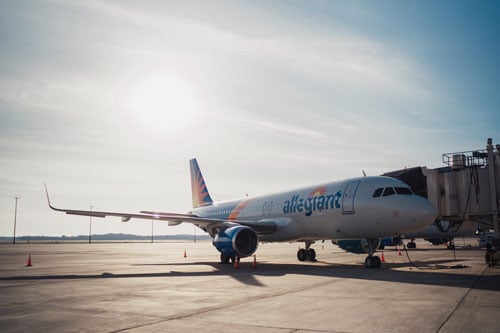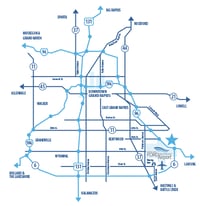Electric Vehicle Charging Stations
At no additional cost, eight universal electric vehicle chargers are located in the Short Term Parking area.
GFIA is committed to meeting and exceeding federal, state, and local regulations for the safety of our guests and community we live and work in.
Zoning Ordinance
Noise Abatement
Storm Water Management
The Gerald R. Ford International Airport Authority (The Authority) views its environmental sustainability efforts as an integral part of its mission and is committed to reducing the airport's impact on the natural environment. Environmental sustainability has been demonstrated as a core component of the Airport's mission since before the Airport opened at its current site in 1963.
The Authority has met many milestones in environmental achievements and in resource conservation over the years. While we take pride in these achievements, under our continuous improvement value, we remain engaged in examining all facets of our airport operation for additional environmental sustainability opportunities.
At no additional cost, eight universal electric vehicle chargers are located in the Short Term Parking area.
Located post-security, these stations will allow you to fill your reusable water bottle. with filtered water.
Thanks to a partnership with Kent County's SORT program, 20 recycling receptacles are located throughout the Airport terminal.
The Gerald R. Ford International Airport Authority (GFIAA) most recently prepared a comprehensive Master Plan Update in 2019 to provide the Gerald R. Ford International Airport (GFIA) with a strategy for the continued development of the airport. The Master Plan Update initiative is an integral tool to lead GFIA’s operational efficiency and business effectiveness into the future.
Under a continuous planning process, Master Plans are reviewed and benchmarked against actual performance. Formal comprehensive Master Plan updates are completed every 7 to 10 years.

In 1950, the State of Michigan passed the Michigan Airport Zoning Act. The purpose of this act was to protect airspace necessary for the safe flight of aircraft in landing or takeoff at an airport. The act provides the opportunity for political subdivisions to adopt, establish, administer, and enforce airport zoning regulations limiting the height of structures and objects of natural growth, and otherwise regulating the use of property within the vicinity of publicly owned airports such, as Gerald R. Ford International Airport.
As the airport was being constructed at the current location in 1961, Kent County adopted the Kent County Airport Zoning Ordinance to provide aviation safety and protection to the users of the airport and to the people who live and work in its vicinity. Then, because of changes in runway configuration, the ordinance was updated in 1995.
The updated ordinance (now the Gerald R. Ford International Airport Authority Airport Zoning Ordinance) limits the height of structures within the vicinity of the airport through an application and permit process. The ordinance requires that persons proposing to build structures apply for an Airport Zoning Permit. Structures that can pose a very real threat to aviation safety include:
Every year, applications are received for proposed cellular or PCS antenna towers, buildings requiring a height variance from your local planning authority, construction cranes, and other structures.
Should you consider construction of any of the above-mentioned structures within a 10 mile radius of the airport, please call the Airport Zoning office at 616-233-6000 and ask for the Airport Planning Engineer, who will explain the Airport Zoning Permit process and assist you in determining if your proposed construction will require a permit. If so, you will be given assistance in filing an application for an Airport Zoning Permit. Or you can complete the Airport Zoning Permit online and submit to the Authority's administrative offices.
In 1979, the Aviation Safety and Noise Abatement Act (ASNA Act) was signed into law. Under the authority of ASNA, the Federal Aviation Regulation (FAR) Part 150 (now the Code of Federal Regulation 14 CFR Part 150) was developed. This regulation prescribes procedures, standards, and methodology for airports participating in the voluntary development of Noise Exposure Maps (NEMs) and Noise Compatibility Programs (NCPs).
NEMs are geographic depictions of an airport, the surrounding community, and the annual noise level contours expressed in a day-night average sound level (DNL). DNL is the federal standard for measuring average sound impacts around airports. The NCP is a program developed in accordance with the 14 CFR Part 150 regulation, which includes measures proposed or taken by the airport operator (Gerald R. Ford International Airport Authority) to reduce existing non-compatible land uses and to prevent the introduction of new non-compatible land uses within the airport area.
In 1988, the Kent County Department of Aeronautics voluntarily initiated a 14 CFR Part 150 Study. The products of this study were federally accepted NEMs and a federally approved NCP. Then in 1999/2000, the Department updated the NEMs, which received federal acceptance on December 27, 2000.
The approved NCP for the Gerald R. Ford International Airport includes 10 program measures. Since approval of this voluntary NCP, the Department of Aeronautics has implemented nine of these measures, and one has been removed from consideration because of lack of a demonstrated need. The Gerald R. Ford International Airport has now completed its NCP.
In compliance with the Federal Water Pollution Control Act and the Michigan Act 451, the GFIA Authority has an approved Storm Water Management Program Plan (SWMPP). Developed as a requirement of the airport's National Pollutant Discharge Elimination System (NPDES) Permit, which is administered by the Michigan Department of Natural Resources & Environment (MDNRE), the plan describes activities to ensure the quality of storm water discharged from the facility.
This permit contains requirements necessary for the Authority to comply with state and federal storm water pollution control laws. The backbone of the plan includes best management practices the airport uses to address six measures for minimizing and preventing storm water pollution, including:
Under this permit, the Authority is tasked with monitoring and reporting responsibilities, as well as several methods used to control storm water discharge from airport property. Also, the airport and airlines utilize Best Management Practices (BMPs) and equipment to comply with the conditions of the permit. Included in the permit are restrictions as to where airport de-icing operations may occur. The equipment includes two mobile de-icing collection units for vacuuming fluid from aircraft ramp areas and catch basin insert valves to allow capture of de-icing fluid prior to entering the storm water system, along with monitoring equipment to allow for proper monitoring and sampling of airport runoff to ensure compliance with the permit.
The Authority and environmental consultants work throughout the year to comply with the NPDES permit. Additionally, major investment items, such as the mobile collection units, are programmed into the airport's capital budget for scheduled purchase and replacement.
You can download the full Stormwater Pollution Prevention Plan (SWPPP) and Spill Prevention, Control and Countermeasures / Pollution Incident Prevention Plan (SPCC/PIPP) below. (NOTE: This 236-page document file is 11 MB)

Subscribe to News & Updates
© Copyright Gerald R. Ford International Airport Authority 2026

5500 44th Street SE, Grand Rapids, MI 49512
Get Directions >